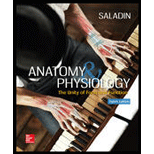
Concept explainers
The integrative functions of the nervous system are performed mainly by
- a. afferent neurons.
- b. efferent neurons.
- c. neuroglia.
- d. sensory neurons.
- e. interneurons.
Introduction:
The nervous system is a complex network of nerve cells. Nerves are the basic unit of the nervous system. The nervous system is classified into two major divisions’ central nervous system and peripheral nervous system. The peripheral nervous system is subdivided into sensory division (afferent) and motor division (efferent).
Answer to Problem 1TYR
Correct answer:
The neurons which receives, process and store information in response to stimuli are known as interneurons. These are integrative functions of the peripheral nervous system. Therefore, option e is correct.
Explanation of Solution
Justify reasons for the correct statement:
The neurons which carry out integrative functions of the nervous system are interneurons. These neurons are useful in making decisions. Interneurons constitute about 90% of the nervous system.
Option (e) is given as, “interneurons”.
The integrative functions are carried out by interneurons. Hence, the option (e) is correct.
Justify reasons for the incorrect statements:
Option (a) is given as, “afferent”.
Afferent neurons conduct signal towards the CNS in response to stimuli, such as heat, light, and so on. Hence, it is a wrong answer.
Option (b) is given as, “efferent”.
Efferent neurons or motor neurons sends signal to the gland cells and the muscle cells. Hence, it is a wrong answer.
Option (c) is given as, “neuroglia”.
Neuroglia is neural cells or supportive cells which protects the neurons in central and peripheral nervous system. Hence, it is a wrong answer.
Option (d) is given as, “sensory neurons”.
Sensory neurons are a special type of neurons which convert external stimuli into action potentials. Hence, it is a wrong answer.
Hence, options (a), (b), (c), and (d) are incorrect.
The integrative functions of nervous system are carried out by type of neurons called the interneurons.
Want to see more full solutions like this?
Chapter 12 Solutions
Anatomy & Physiology: The Unity of Form and Function
Additional Science Textbook Solutions
Human Biology: Concepts and Current Issues
SEELEY'S ANATOMY+PHYSIOLOGY
Principles of Anatomy and Physiology
Microbiology: An Introduction
Campbell Biology: Concepts & Connections (9th Edition)
Human Biology: Concepts and Current Issues (8th Edition)
- Neurons contain ________, which can receive signals from other neurons. a. axons b. mitochondria c. dendrites d. Golgibodiesarrow_forwardWhich part of the nervous system directly controls the digestive system? a. parasympathetic nervous system b. central nervous system c. spinal cord d. sensory-somatic nervous systemarrow_forwardAutomatic bodily functions such as breathing andswallowing are controlled by thea. pons and medulla.b. thalamus.c. midbrain.d. cerebral cortex.arrow_forward
- Which of the following cavities contains a component of the central nervous system? a. abdominal b. pelvic c. cranial d. thoracicarrow_forwardMeningitis is a viral or bacterial infection of the brain. Which cell type is the first to have its function disrupted during meningitis? a. astrocytes b. microglia c. neurons d. satellite gliaarrow_forwardDescribe What are the main divisions of Nervous system?arrow_forward
- What are the components and roles of the peripheral nervous systemarrow_forwardThe brain knows whether an incoming nerve impulse is light, sound, or pain because of thea. nature of the sensory receptor.b. frequency of the sensory signal.c amplitude of the sensory signal.d. wiring to specific CNS locations.arrow_forwardGanglia are ... a) ... collections of nerve cell bodies outside the CNS b) ... part of a nerve cell c) ... the connection between two nerve cells d) ... collections of nerve fibers in the CNS e) ... a type of glial cells in the brainarrow_forward
- Explain the concept map of the nervous systemarrow_forwardEmergency room doctors often shine a light into the eyes of patients with head injuries to test their pupillary reflex. The structure that relays the information between the optic nerve and the motor neuron, and the division of the nervous system that the structure is part of , respectively are: Select one: a. an interneuron and the peripheral nervous system b. the occipital lobe and the peripheral nervous system c. the occipital lobe and the central nervous system d. an interneuron and the central nervous systemarrow_forwardWhich of the following brain regions is not correctly matched to itsfunction?a. The medulla oblongata regulates heartbeat, breathing, and bloodpressure.b. The cerebellum coordinates voluntary muscle movements.c. The thalamus secretes melatonin, which regulates daily bodyrhythms.d. The midbrain acts as a refl ex center for visual, auditory, andtactile responses.arrow_forward
 Concepts of BiologyBiologyISBN:9781938168116Author:Samantha Fowler, Rebecca Roush, James WisePublisher:OpenStax College
Concepts of BiologyBiologyISBN:9781938168116Author:Samantha Fowler, Rebecca Roush, James WisePublisher:OpenStax College



